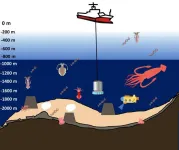(Press-News.org) Philadelphia, April 14, 2025 – Researchers have demonstrated the potential of the innovative optical genome mapping (OGM) technique for the diagnosis, prognosis, and therapeutic management of multiple myeloma. This new study in The Journal of Molecular Diagnostics, published by Elsevier, details how this novel method can establish the cytogenomic profile of the tumor on a scale suitable for routine practice in cytogenetics laboratories.
Multiple myeloma, a type of blood cancer that forms in plasma cells (a type of white blood cells), is the second most common hematologic malignancy. Over the past few decades, the introduction of novel therapies has significantly improved progression-free survival and overall survival, with less toxicity and an improved quality of life. Nevertheless, the disease remains largely incurable with poor outcomes, especially among patients resistant to multiple drug classes.
Cytogenetic gold standard workflow in multiple myeloma first starts with the isolation of tumor cells, which is an essential prerequisite, followed by traditional routine techniques (fluorescent in situ hybridization, “FISH”). However, cell sorting often limits the number of markers that can be investigated due to low cell yields. Even though some other techniques such as high throughput DNA sequencing require fewer cells, the search for markers remains targeted and not exhaustive.
This study presents an innovative approach combining the cutting-edge OGM technique, capable of identifying structural variants and copy number variations across the entire genome on a single test with the mix of tumor and non-tumor fraction for each patient to overcome the issue of low cell amount after cell sorting.
Lead investigator Agnès Daudignon, PhD, Institute of Medical Genetics, Lille University Hospital, and Hematology and Immunology Laboratory, Valenciennes University Hospital (France), explains, "We wanted to test the feasibility of OGM in the genetic management of multiple myeloma to establish the cytogenomic profile of the tumor on a scale suitable for routine practice in cytogenetics laboratories.”
Investigators tested the OGM technique and confirmed the possibility of reducing the number of cells required. They demonstrated that the technique can be applied to pure sorted samples diluted up to 50% for complete detection of clonal structural variants and copy number variants, with a detection threshold of at least 20% for copy number variants at 50%. Analysis of a small series of patients showed a 93% concordance with the reference FISH technique on five tested markers and allowed the identification of more than 22 additional genomic variations of interest. This method streamlines several analyses into a single test, reduces material requirements, and improves prognostic stratification for patients with multiple myeloma.
The pan-genomic nature of this technology, combined with the concept of mixing tumor and non-tumor cells, makes this research particularly innovative. It allows for the visualization of all rearrangements and numerical anomalies of the samples in a single layer, providing local laboratories and/or routine hospital settings with an excellent level of detection of multiple myeloma markers, which could be described as pan-genomic technology on a human scale.
Dr. Daudignon concludes, "Of course, this technology does not allow for the detection of point mutations in genes, since it is not a sequencing technique. However, we have demonstrated that targeted complementary research for mutations on certain genes of interest can be performed using the same DNA sample extracted for the OGM, meaning there is no need to collect a new sample from the patient. Our research shows that integrating OGM into laboratory workflows would enhance prognostic stratification and expand therapeutic options."
END
Cutting-edge optical genome mapping technology shows promise for diagnosis, prognosis, and therapeutic options of multiple myeloma
A study published in The Journal of Molecular Diagnostics describes an innovative method for routine use in cytogenetic laboratories
2025-04-14
ELSE PRESS RELEASES FROM THIS DATE:
Study looks at impact of COVID-19 pandemic on rates of congenital heart disease procedures among children
2025-04-14
Major reallocation of healthcare services during the COVID-19 pandemic meant that elective surgery in children with congenital heart disease (CHD) was significantly reduced, so that those needing urgent, lifesaving and emergency surgery could be treated. However, this prioritisation of the most severely ill children did not increase overall post-operative complications rates or death, a study led by the University of Bristol has shown.
The research, published in Open Heart, suggests that prioritising surgery for younger and more critically ill children may be appropriate when there is a sudden disruption of usual care. The ...
UH researcher unveils new model to evaluate impact of extreme events and natural hazards
2025-04-14
When you’re on a sandy beach or the banks of a river, transformed by rolling waves or slightly still waters, it’s likely you’re not thinking about what happens just beneath the surface, where dirt and pollution are swirling and traveling through to new destinations.
But Hanadi Rifai does. The Moores Professor of Civil and Environmental Engineering and director of the Hurricane Resilience Research Institute, has spent two decades examining Galveston Bay – its tides, currents ...
Illegal poisonings imperil European raptors and could disrupt ecosystem health
2025-04-14
A recent comprehensive assessment on the poisoning of raptors across Europe does not yield good news. This is according to the new paper “Poisoning in Europe Between 1996 and 2016: A Continental Assessment of the Most Affected Species and the Most Used Poisons,” published in the Journal of Raptor Research. A large team of raptor researchers amassed retrospective data on poisoning events across 22 European countries between 1996 and 2016. Carbofuran and aldicarb were the most common toxins reported and disproportionately affected scavenging raptors, especially in Northern ...
UF professor develops AI tool to better assess Parkinson’s disease, other movement disorders
2025-04-14
A University of Florida researcher has developed a groundbreaking open-source computer program that uses artificial intelligence to analyze videos of patients with Parkinson's disease and other movement disorders. The tool, called VisionMD, helps doctors more accurately monitor subtle motor changes, improving patient care and advancing clinical research.
Diego Guarin, Ph.D., an assistant professor of applied physiology and kinesiology in UF’s College of Health and Human Performance, created the software to address the potential risk of inconsistency ...
Computer science professor elected AAAS Fellow
2025-04-14
Dr. Latifur Khan, professor of computer science at The University of Texas at Dallas, has been elected to the 2024 class of American Association for the Advancement of Science (AAAS) fellows.
Khan is one of 471 scientists, engineers and innovators to be recognized across 24 disciplinary sections. The new fellows will be honored at a June 7 event in Washington, D.C.
The AAAS elected Khan in the section on information, computing and communication for “distinguished contributions to the field of machine learning with applications to cybersecurity, social sciences ...
Learning about social interaction by studying dancing
2025-04-14
Dancing fluidly with another involves social coordination. This skill entails aligning movements with others while also processing dynamic sensory information, like sounds and visuals. In a new JNeurosci paper, Félix Bigand and Giacomo Novembre, from the Italian Institute of Technology, Rome, and colleagues report their findings on how the brain drives social coordination during dance.
The researchers recruited pairs of inexperienced dancers and recorded their brain activity, whole-body movements, and ...
Immune cell 'messengers' could save crumbling bones - new hope for joint pain sufferers
2025-04-14
A recent study has uncovered a potential breakthrough in treating osteonecrosis of the femoral head (ONFH), a debilitating bone disease that causes severe pain and joint collapse. Researchers have discovered that exosomes derived from M2 macrophages-derived exosomes (M2-Exos) can significantly improve bone regeneration by modulating neutrophil extracellular traps (NETs) and endothelial cell function. These tiny vesicles, packed with miR-93-5p, were shown to reduce harmful NETs formation and enhance ...
Fishing for cephalopod DNA allows for efficient marine surveying
2025-04-14
New DNA probes allow for efficient surveying of the hidden lives of squids and octopuses in the deep sea. This development by Kobe University provides an effective tool for marine ecological research and conservation efforts.
Squids and octopuses eat and are eaten, and in between that they move around a lot. “Cephalopods play an important role in marine ecosystems, contributing to the distribution of energy and nutrients in the food web,” explains Kobe University marine ecologist WU Qianqian. And while for ecological research it is therefore essential to know about the distribution ...
Having a 'therapist in your pocket' curbs depression among primary care patients
2025-04-14
Patients with depression who received the Moodivate app saw clinically meaningful reductions in their symptoms that were twice those achieved with standard-of-care therapy in a clinical trial conducted at 22 primary care practices in Charleston, South Carolina. App users were also 3 times more likely to achieve a clinically meaningful improvement in their depression and 2.3 times more likely to attain depression remission. Moodivate (available on both iOS and Android) is a digital version of behavioral activation, a type of behavioral therapy that has proved effective against depression. Jennifer Dahne, Ph.D., professor in the Department of Psychiatry and Behavioral ...
Hospital visits for cannabis use linked to higher dementia risk, study finds
2025-04-14
Ottawa, ON, April 14, 2025 – Individuals with an emergency department (ED) visit or hospitalization due to cannabis were at 23% and 72% greater risk of a new dementia diagnosis within five years compared to individuals with an ED visit or hospitalization for any other reason or the general population, according to a new study published in JAMA Neurology.
“Long-term and heavy cannabis use has been associated with memory problems in midlife along with changes in brain structure associated with dementia,” says Dr. Daniel Myran, a Canada Research Chair in Social ...
LAST 30 PRESS RELEASES:
World-first discovery uncovers how glioblastoma tumours dodge chemotherapy, potentially opening the door to new treatments
A fatal mix-up: How certain gut bacteria drive multiple sclerosis
New AI tool identifies not just genetic mutations, but the diseases they may cause
Deep-learning model predicts how fruit flies form, cell by cell
Combination pills for high blood pressure may simplify treatment, improve long-term health
Immune system keeps mucosal fungi in check
Neurons within the brain use simple rules to localize genetic messages
Electrodes created using light
Second-hand gift-giving is a well-deliberated decision
How human interaction drove evolution to make bears less aggressive
National Poll: Few parents offer teens guidance on healthy eating during holiday season
Cannabis derivatives could provide new ovarian cancer treatments
Raising strong yeast as a petroleum substitute
Clues to the origin of hot Jupiters hidden in their orbits
Canada’s reduced pledge to Global Fund will impact domestic health
1 in 4 children with major traumatic injuries not cared for in pediatric trauma centres
Duke and Duke-NUS’ joint cross-population research to uncover "East-West" differences in disease and care
Scientists to ‘spy’ on cancer- immune cell interactions using quantum technology breakthrough
Tech savvy users have most digital concerns
Making lighter work of calculating fluid and heat flow
Normalizing blood sugar can halve heart attack risk
Lowering blood sugar cuts heart attack risk in people with prediabetes
Study links genetic variants to risk of blinding eye disease in premature infants
Non-opioid ‘pain sponge’ therapy halts cartilage degeneration and relieves chronic pain
AI can pick up cultural values by mimicking how kids learn
China’s ecological redlines offer fast track to 30 x 30 global conservation goal
Invisible indoor threats: emerging household contaminants and their growing risks to human health
Adding antibody treatment to chemo boosts outcomes for children with rare cancer
Germline pathogenic variants among women without a history of breast cancer
Tanning beds triple melanoma risk, potentially causing broad DNA damage
[Press-News.org] Cutting-edge optical genome mapping technology shows promise for diagnosis, prognosis, and therapeutic options of multiple myelomaA study published in The Journal of Molecular Diagnostics describes an innovative method for routine use in cytogenetic laboratories





